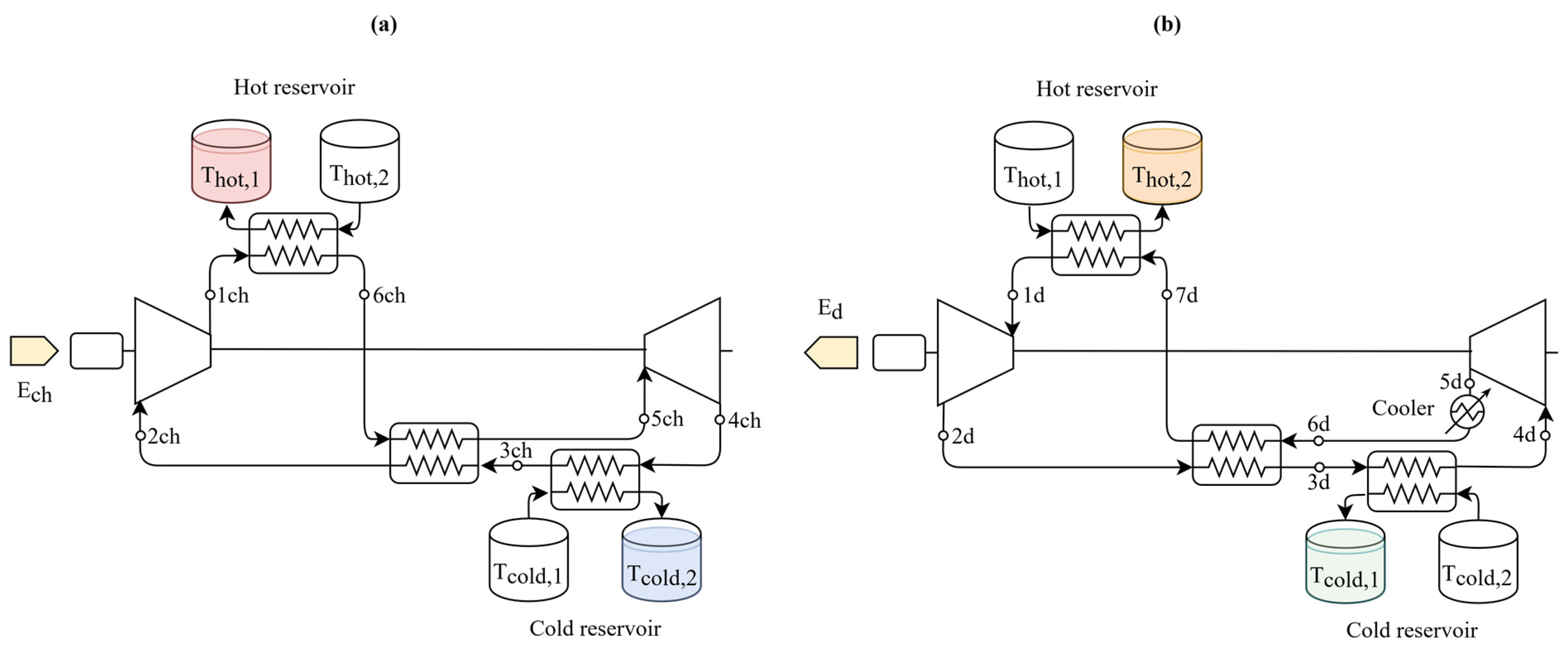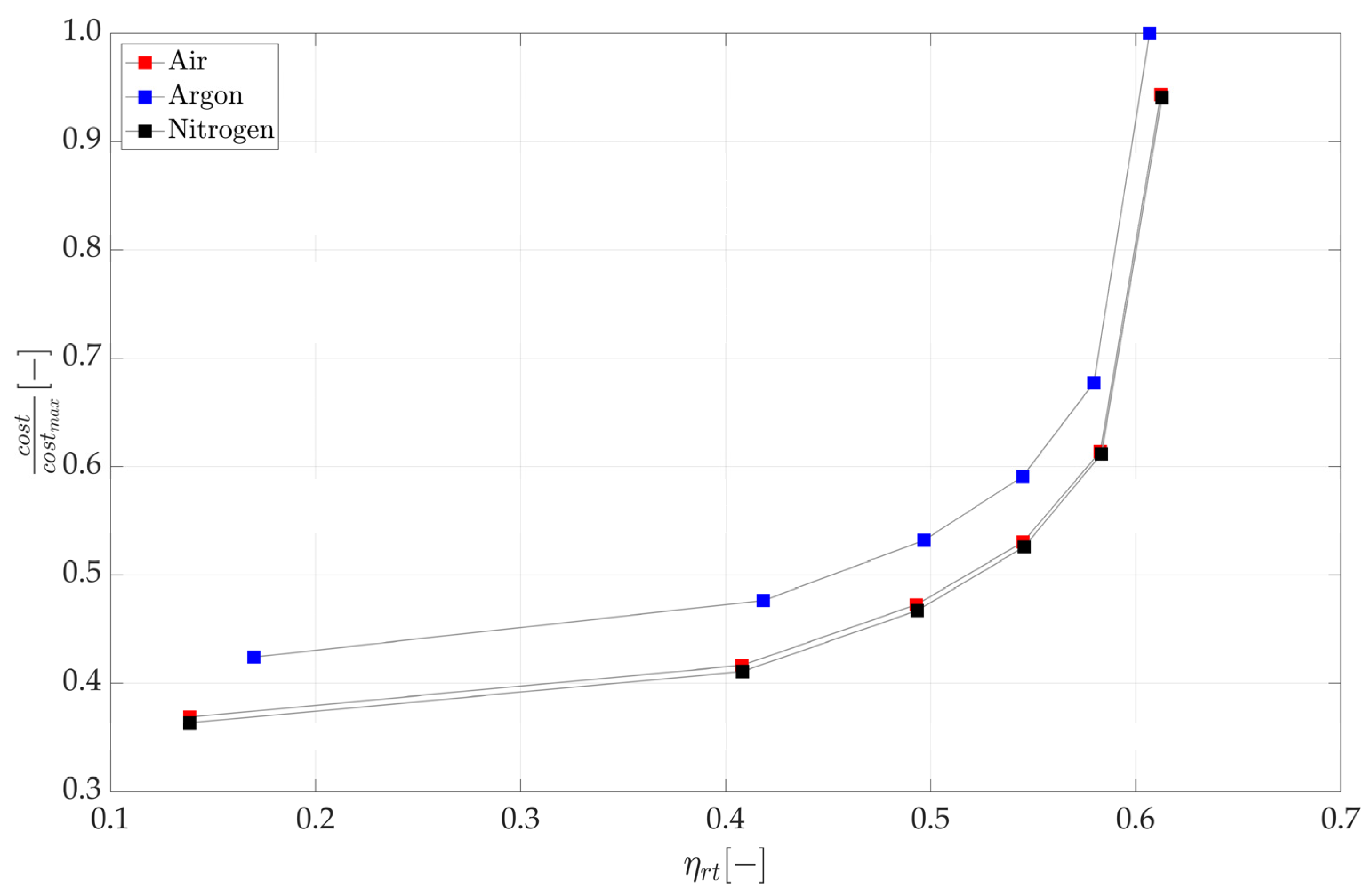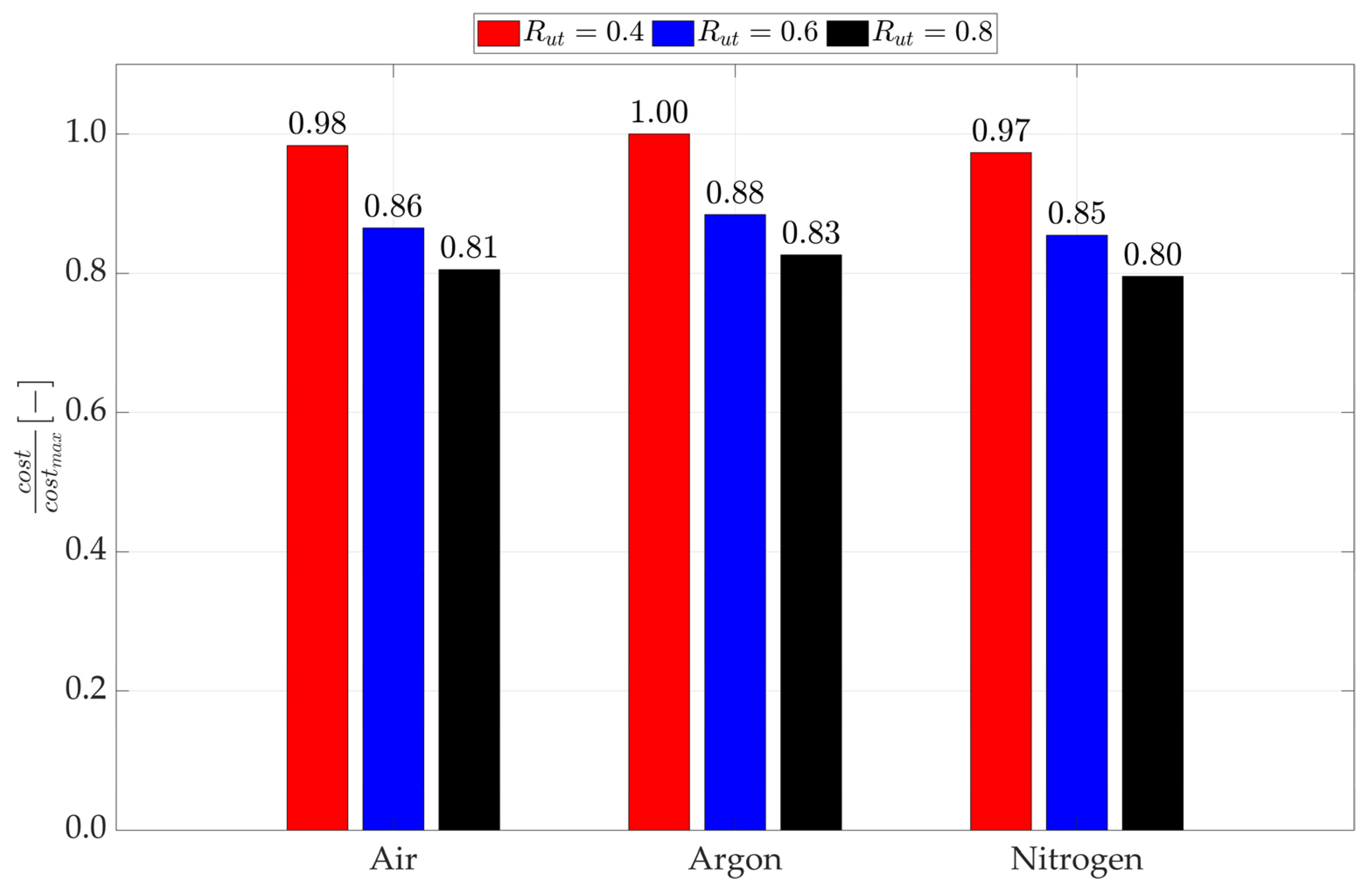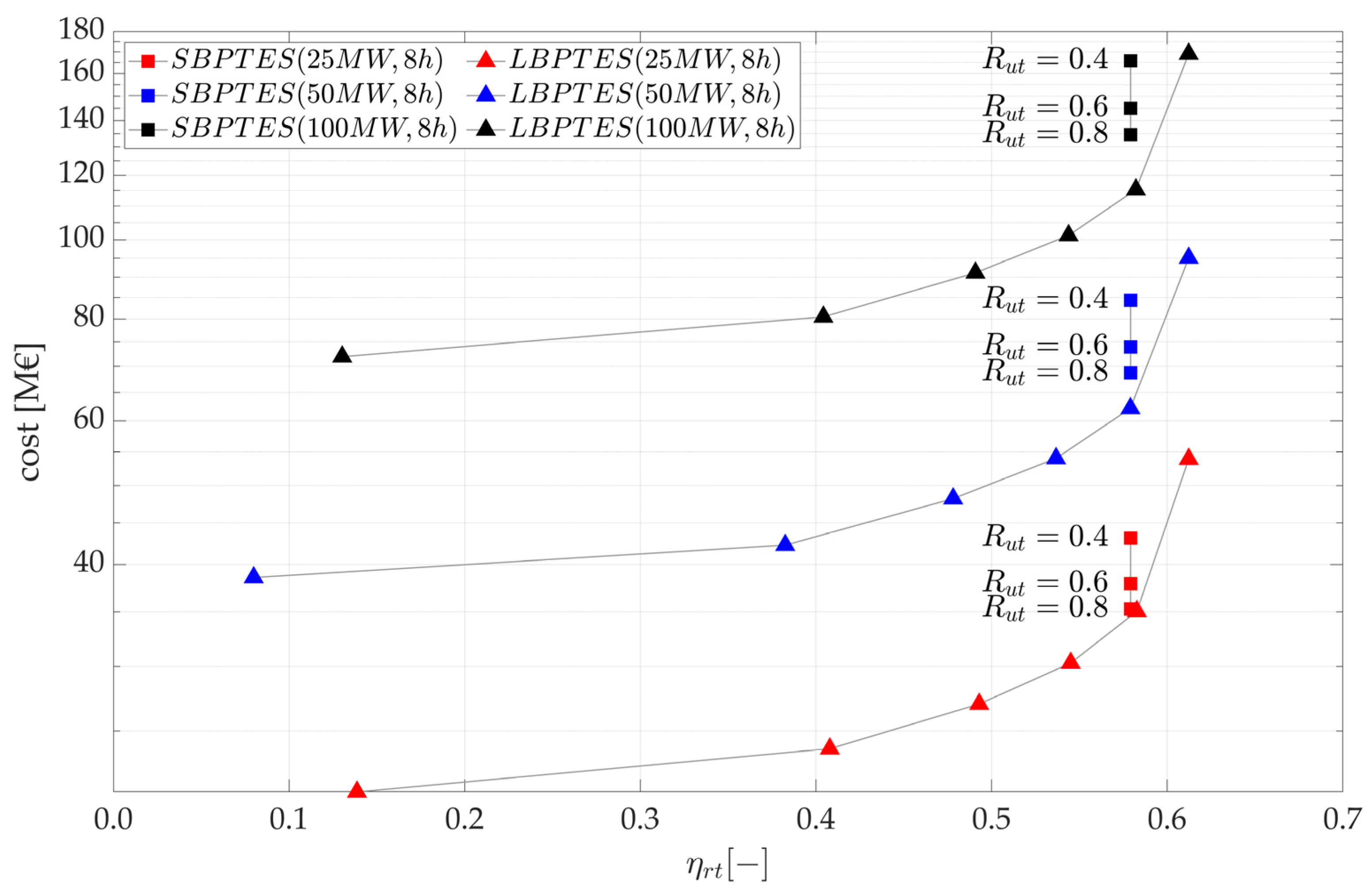Techno-Economic Comparison of Brayton Pumped Thermal Electricity Storage (PTES) Systems Based on Solid and Liquid Sensible Heat Storage
Abstract
1. Introduction
1.1. Framework of the Analysis
1.2. Research Gaps, Paper Activities, and Innovative Contributions
- The impact on the LBPTES and SBPTES performance and cost of three different operating fluids (i.e., argon, nitrogen, and air) was assessed in order to select the most cost-effective alternative;
- An economic comparison between the solid-based and liquid-based Brayton PTES was performed to select the most cost-effective configuration, guide future research and designs and understand the main cost drivers of the two technologies.
1.3. Organisation of the Material
2. Brayton PTES Operating Principle, Components, and Techno-Economic Analysis
2.1. Solid- and Liquid-Based PTES Operating Principles and Configurations
2.2. Techno-Economic Comparison of Liquid- and Solid-Based Brayton PTES
- Different TES materials;
- Costly heat transfer equipment in LBPTES, which is absent in SBPTES;
- Internal regeneration that (i) increases the heat transfer equipment cost in LBPTES, but (ii) it may lead to cheaper turbomachines in LBPTES than in SBPTES;
- Actual SBPTES capacity utilisation, which increases the SBPTES cost per stored kWh compared to what is expected based on the material properties.
2.3. Other Elements Impacting the Comparison between Solid-a and Liquid-Based Systems
3. Methodology
3.1. Roundtrip Efficiency Calculation
3.2. Brayton PTES Cost Calculation
3.3. LBPTES and SBPTES Optimised Plant Design
3.4. LBPTES and SBPTES Operating Temperatures and Other Influential Parameters
3.5. Simulated Cases
4. Results and Discussion
4.1. Brayton Cycle Fluid Selection
- The roundtrip efficiency is almost independent of the cycle fluid, as in all cases the same maximum efficiencies can be achieved;
- Using nitrogen led to a systematically cheaper system than argon and air;
- However, the cost difference between the systems operating with nitrogen and air was minimal and within the cost correlation error band, which can be as high as ±30% in some cases [42].
4.2. Comparison between LBPTES and SBPTES
- LBPTES and SBPTES systems were practically equivalent, as far as the roundtrip efficiency was concerned, and realistic (i.e., potentially cost effective) configurations were considered instead of maximum efficiency ones;
- LBPTES can achieve the same roundtrip efficiency as the SBPTES for a lower cost, and the cost gap between the technologies widens as the size of systems increases;
- Configurations with high capacity utilisation ratios (Rut ≥ 0.8) are mandatory to make SBPTES competitive with LBPTES of similar sizes, which means that strategies aimed at improving the packed-bed utilisation are likely to be the standard if SBPTES becomes widespread.
- LBPTES had a significantly lower cost per MWh than SBPTES. Even for Rut = 0.8, the SBPTES cost per MWh was almost double the LBPTES;
- The heat exchangers did not significantly penalise LBPTES, which achieved costs per MW similar to SBPTES. A clear cost advantage of SBPTES over LBPTES was visible only for limited power ratings ( = 25 MW), whereas for large plants ( ≥ 50 MW), LBPTES would be the cheapest alternative.
4.3. Policy Implications
5. Conclusions
- Air should be used as operating fluid in both LBPTES and SBPTES systems. The nitrogen configurations were the cheapest, but the cost difference between this fluid and air was approximately 1–2 percentage points for both SBPTES and LBPTES. With such limited differences, there are no real economic advantages over air, which is inexpensive and less prone to infiltration or leakages. Using argon led to costlier systems. The cost difference between aragon and air was approximately 3% for SBPTES, while it was between 4% and 7% for LBPTES. Therefore, argon should be avoided;
- For roundtrip efficiencies up to up ηrt = 0.58, LBPTES was always cheaper than SBPTES for any size over 25 MW/8 h. LBPTES can achieve higher efficiencies, up to approximately 0.61, but any increment over 0.58 is most likely not cost effective: for a 5% efficiency increment, from 0.58 to 0.61, the cost would increase up to approximately 35%. The situation is the opposite for systems with smaller nominal power ratings and charging durations, and SBPTES could be a cheaper alternative to LBPTES;
- SBPTES was costlier than LBPTES, despite using cheaper TES materials and fewer components for two reasons:
- The materials represent only a minor share of the total cost, less than 1% in SBPTES and approximately 7% in LBPTES. The cost of the containers always dominated the TES cost, accounting for over 60% in LBPTES and 90% in SBPTES. In the case of SBPTES, pressurised vessels must be used instead of atmospheric tanks, which results in a much higher cost;
- SBPTES operates with larger pressure ratios than LBPTES, which makes its turbomachines costlier. LBPTES is based on a recuperated cycle, which achieves the same efficiency for a lower pressure ratio. Machines accounted for over 70% of total cost in SBPTES and 31% in LBPTES;
- The cost difference between LBPTES and SBPTES increases with the nominal power rating. This is because of the cost of machines are linear with the size, which impacts more on SBPTES than on LBPTES. For large power ratings (over 50 MW), the LBPTES cost per kW is lower than for SBPTES, since the cost of the heat exchangers, representing more than 50% of the total, increases less than that of the machines.
Author Contributions
Funding
Data Availability Statement
Conflicts of Interest
Appendix A
Appendix B
Appendix C
References
- European Parliament and the Council of the European Union Renewable Energy Directive. Available online: https://ec.europa.eu/energy/topics/renewable-energy/renewable-energy-directive/overview_en (accessed on 6 April 2021).
- European Commission A European Green Deal. Available online: https://ec.europa.eu/info/strategy/priorities-2019-2024/european-green-deal_en#actions (accessed on 15 July 2021).
- Palizban, O.; Kauhaniemi, K. Energy storage systems in modern grids—Matrix of technologies and applications. J. Energy Storage 2016, 6, 248–259. [Google Scholar] [CrossRef]
- Zappa, W.; Junginger, M.; van den Broek, M. Is a 100% renewable European power system feasible by 2050? Appl. Energy 2019, 233–234, 1027–1050. [Google Scholar] [CrossRef]
- Argyrou, M.C.; Christodoulides, P.; Kalogirou, S.A. Energy storage for electricity generation and related processes: Technologies appraisal and grid scale applications. Renew. Sustain. Energy Rev. 2018, 94, 804–821. [Google Scholar] [CrossRef]
- Rogner, M.; Troja, N. The world’s water battery: Pumped hydropower storage and the clean energy transition. IHA Work. Pap. 2018, 1, 1–15. [Google Scholar]
- Dumont, O.; Frate, G.F.; Pillai, A.; Lecompte, S.; De paepe, M.; Lemort, V. Carnot battery technology: A state-of-the-art review. J. Energy Storage 2020, 32, 101756. [Google Scholar] [CrossRef]
- Bublitz, A.; Keles, D.; Zimmermann, F.; Fraunholz, C.; Fichtner, W. A survey on electricity market design: Insights from theory and real-world implementations of capacity remuneration mechanisms. Energy Econ. 2019, 80, 1059–1078. [Google Scholar] [CrossRef]
- Frate, G.F.; Ferrari, L.; Desideri, U. Energy storage for grid-scale applications: Technology review and economic feasibility analysis. Renew. Energy 2021, 163, 1754–1772. [Google Scholar] [CrossRef]
- Laughlin, R.B. Pumped thermal grid storage with heat exchange. J. Renew. Sustain. Energy 2017, 9, 044103. [Google Scholar] [CrossRef]
- Salomone-González, D.; González-Ayala, J.; Medina, A.; Roco, J.M.M.; Curto-Risso, P.L.; Calvo Hernández, A. Pumped heat energy storage with liquid media: Thermodynamic assessment by a Brayton-like model. Energy Convers. Manag. 2020, 226, 113540. [Google Scholar] [CrossRef]
- Zhao, Y.; Liu, M.; Song, J.; Wang, C.; Yan, J.; Markides, C.N. Advanced exergy analysis of a Joule-Brayton pumped thermal electricity storage system with liquid-phase storage. Energy Convers. Manag. 2021, 231, 113867. [Google Scholar] [CrossRef]
- Desrues, T.; Ruer, J.; Marty, P.; Fourmigué, J.F. A thermal energy storage process for large scale electric applications. Appl. Therm. Eng. 2010, 30, 425–432. [Google Scholar] [CrossRef]
- Zhang, H.; Wang, L.; Lin, X.; Chen, H. Combined cooling, heating, and power generation performance of pumped thermal electricity storage system based on Brayton cycle. Appl. Energy 2020, 278, 115607. [Google Scholar] [CrossRef]
- Wang, L.; Lin, X.; Chai, L.; Peng, L.; Yu, D.; Chen, H. Cyclic transient behavior of the Joule–Brayton based pumped heat electricity storage: Modeling and analysis. Renew. Sustain. Energy Rev. 2019, 111, 523–534. [Google Scholar] [CrossRef]
- Wang, L.; Lin, X.; Zhang, H.; Peng, L.; Chen, H. Brayton-cycle-based pumped heat electricity storage with innovative operation mode of thermal energy storage array. Appl. Energy 2021, 291, 116821. [Google Scholar] [CrossRef]
- Raj, A.; Philippe, L. Use of External Air for Closed Cycle Inventory Control. U.S. Patent 20180187627-A1, 28 December 2016. [Google Scholar]
- Mctigue, J.D.; Farres-antunez, P.; Markides, C.N.; White, A.J. Techno-economic analysis of recuperated Joule-Brayton pumped thermal energy storage. Energy Convers. Manag. 2022, 252, 115016. [Google Scholar] [CrossRef]
- Zhang, H.; Wang, L.; Lin, X.; Chen, H. Technical and economic analysis of Brayton-cycle-based pumped thermal electricity storage systems with direct and indirect thermal energy storage. Energy 2022, 239, 121966. [Google Scholar] [CrossRef]
- Kotas, T.J. Chapter 2: Basic Exergy Concepts. In The Exergy Method of Thermal Plant Analysis; Elsevier: Amsterdam, The Netherlands, 1985; pp. 29–56. ISBN 978-0-408-01350-5. [Google Scholar]
- Laughlin, R.B. Mass Grid Storage with Reversible Brayton Engines. In Thermal, Mechanical, and Hybrid Chemical Energy Storage Systems; Brun, K., Allison, T., Dennis, R., Eds.; Academic Press: Cambridge, MA, USA, 2021; pp. 27–59. ISBN 978-0-12-819892-6. [Google Scholar]
- Harris, P.; Wolf, T.; Kesseli, J.; Laughlin, R.B. An Investigation of Reversing Axial Turbomachinery for Thermal Energy Storage Application. In Proceedings of the Volume 5: Controls, Diagnostics, and Instrumentation, Cycle Innovations: Energy Storage, American Society of Mechanical Engineers, Virtual, Online, 21–25 September 2020. [Google Scholar]
- Chiapperi, J.D.; Greitzer, E.M.; Tan, C.S. Attributes of Bi-Directional Turbomachinery for Pumped Thermal Energy Storage. J. Turbomach. 2023, 145, 1–21. [Google Scholar] [CrossRef]
- Liang, T.; Vecchi, A.; Knobloch, K.; Sciacovelli, A.; Engelbrecht, K.; Li, Y.; Ding, Y. Key components for Carnot Battery: Technology review, technical barriers and selection criteria. Renew. Sustain. Energy Rev. 2022, 163, 112478. [Google Scholar] [CrossRef]
- Hamdy, S.; Morosuk, T.; Tsatsaronis, G. Exergetic and economic assessment of integrated cryogenic energy storage systems. Cryogenics 2019, 99, 39–50. [Google Scholar] [CrossRef]
- Malta, Thermo-Electric Energy Storage. Available online: https://www.maltainc.com/solution/ (accessed on 8 November 2022).
- Apte, R.; Philippe, L. Variable Pressure Inventory Control of Closed Cycle System with a High Pressure Tank and an Intermediate Pressure Tank; Malta Inc.: Cambridge, MA, USA, 2016. [Google Scholar]
- Steinmann, W.-D.; Jockenhöfer, H.; Bauer, D. Thermodynamic Analysis of High-Temperature Carnot Battery Concepts. Energy Technol. 2020, 8, 1900895. [Google Scholar] [CrossRef]
- Steinmann, W.D. Thermo-mechanical concepts for bulk energy storage. Renew. Sustain. Energy Rev. 2017, 75, 205–219. [Google Scholar] [CrossRef]
- Olympios, A.V.; McTigue, J.D.; Farres-Antunez, P.; Tafone, A.; Romagnoli, A.; Li, Y.; Ding, Y.; Steinmann, W.-D.; Wang, L.; Chen, H.; et al. Progress and prospects of thermo-mechanical energy storage—A critical review. Prog. Energy 2021, 3, 022001. [Google Scholar] [CrossRef]
- Benato, A.; Stoppato, A. Pumped Thermal Electricity Storage: A technology overview. Therm. Sci. Eng. Prog. 2018, 6, 301–315. [Google Scholar] [CrossRef]
- Benato, A.; Stoppato, A. Heat transfer fluid and material selection for an innovative Pumped Thermal Electricity Storage system. Energy 2018, 147, 155–168. [Google Scholar] [CrossRef]
- Esence, T.; Bruch, A.; Molina, S.; Stutz, B.; Fourmigué, J.-F. A review on experience feedback and numerical modeling of packed-bed thermal energy storage systems. Sol. Energy 2017, 153, 628–654. [Google Scholar] [CrossRef]
- Strasser, M.N.; Selvam, R.P. A cost and performance comparison of packed bed and structured thermocline thermal energy storage systems. Sol. Energy 2014, 108, 390–402. [Google Scholar] [CrossRef]
- Ni, F.; Caram, H.S. Analysis of pumped heat electricity storage process using exponential matrix solutions. Appl. Therm. Eng. 2015, 84, 34–44. [Google Scholar] [CrossRef]
- Frate, G.F.; Paternostro, L.; Ferrari, L.; Desideri, U. Off-Design of a Pumped Thermal Energy Storage Based on Closed Brayton Cycles. In Proceedings of the ASME Turbo Expo 2021: Turbomachinery Technical Conference and Exposition. Controls, Diagnostics, and Instrumentation, Cycle Innovations: Energy Storage, Education; Electric Power, American Society of Mechanical Engineers, Virtual, 7–11 June 2021; Volume 4, pp. 1–14. [Google Scholar]
- White, A.J.; McTigue, J.D.; Markides, C.N. Analysis and optimisation of packed-bed thermal reservoirs for electricity storage applications. Proc. Inst. Mech.Eng. Part A J. Power Energy 2016, 230, 739–754. [Google Scholar] [CrossRef]
- McTigue, J.D.; Markides, C.N.; White, A.J. Performance response of packed-bed thermal storage to cycle duration perturbations. J. Energy Storage 2018, 19, 379–392. [Google Scholar] [CrossRef]
- Miettinen, K. Nonlinear Multiobjective Optimization. In International Series in Operations Research & Management Science; Springer: Boston, MA, USA, 1998; Volume 12, ISBN 978-1-4613-7544-9. [Google Scholar]
- MathWorks Constrained Nonlinear Optimization Algorithms. Available online: https://it.mathworks.com/help/optim/ug/constrained-nonlinear-optimization-algorithms.html#f26684 (accessed on 21 August 2019).
- Nocedal, J.; Wright, S.J. Sequential Quadratic Programming. In Numerical Optimization; Springer: New York, NY, USA, 2006; pp. 529–561. ISBN 0-387-30303-0. [Google Scholar]
- Lemmens, S. Cost engineering techniques and their applicability for cost estimation of organic rankine cycle systems. Energies 2016, 9, 485. [Google Scholar] [CrossRef]
- Agazzani, A.; Massardo, A.F. A Tool for Thermoeconomic Analysis and Optimization of Gas, Steam and Combined Plants. In Proceedings of the ASME 1996 International Gas Turbine and Aeroengine Congress and Exhibition, Coal, Biomass and Alternative Fuels, Combustion and Fuels; Oil and Gas Applications, Cycle Innovations, Birmingham, UK, 10–13 June 1996; Volume 3. [Google Scholar]
- Budt, M.; Wolf, D.; Span, R.; Yan, J. A review on compressed air energy storage: Basic principles, past milestones and recent developments. Appl. Energy 2016, 170, 250–268. [Google Scholar] [CrossRef]
- Mongird, K.; Viswanathan, V.; Alam, J.; Vartanian, C.; Sprenkle, V.; Baxter, R. 2020 Grid Energy Storage Technology Cost and Performance Assessment; U.S. Department of Energy: Washington, WA, USA, 2020.
- Morgan, R.; Nelmes, S.; Gibson, E.; Brett, G. Liquid air energy storage—Analysis and first results from a pilot scale demonstration plant. Appl. Energy 2015, 137, 845–853. [Google Scholar] [CrossRef]
- Turton, R.; Shaeiwitz, J.A.; Whiting, W.B.; Bhattacharyya, D. Cost Equations and Curves for the CAPCOST Program. In Analysis, Synthesis and Design of Chemical Processes; Prentice Hall: Hoboken, NJ, USA, 2018; pp. 1283–1311. ISBN 0-13-417740-1. [Google Scholar]
- Weiland, N.T.; Lance, B.W.; Pidaparti, S.R. sCO2 Power Cycle Component Cost Correlations From DOE Data Spanning Multiple Scales and Applications. In Proceedings of the Proceedings of ASME Turbo Expo 2019: Turbomachinery Technical Conference and Exposition SAND2019-1762C GT2019, American Society of Mechanical Engineers, Phoenix, AZ, USA, 17–21 June 2019. [Google Scholar]
- Valero, A.; Lozano, M.A.; Serra, L.; Tsatsaronis, G.; Pisa, J.; Frangopoulos, C.; von Spakovsky, M.R. CGAM problem: Definition and conventional solution. Energy 1994, 19, 279–286. [Google Scholar] [CrossRef]
- Biondi, M.; Giovannelli, A.; Di Lorenzo, G.; Salvini, C. Techno-economic analysis of a sCO2 power plant for waste heat recovery in steel industry. Energy Rep. 2020, 6, 298–304. [Google Scholar] [CrossRef]
- Crespi, F.; Sánchez, D.; Rodríguez, J.M.; Gavagnin, G. Fundamental Thermo-Economic Approach to Selecting sCO2 Power Cycles for CSP Applications. Proc. Energy Procedia 2017, 129, 963–970. [Google Scholar] [CrossRef]
- Nami, H.; Mahmoudi, S.M.S.; Nemati, A. Exergy, economic and environmental impact assessment and optimization of a novel cogeneration system including a gas turbine, a supercritical CO2 and an organic Rankine cycle (GT-HRSG/SCO2). Appl. Therm. Eng. 2017, 110, 1315–1330. [Google Scholar] [CrossRef]
- Ho, C.K.; Carlson, M.; Garg, P.; Kumar, P. Cost and Performance Tradeoffs of Alternative Solar-Driven S-CO2 Brayton Cycle Configurations. In Proceedings of the ASME 2015 9th International Conference on Energy Sustainability collocated with the ASME 2015 Power Conference, the ASME 2015 13th International Conference on Fuel Cell Science, Engineering and Technology, and the ASME 2015 Nuclear Forum; American Society of Mechanical Engineers, San Diego, CA, USA, 28 June–2 July 2015. [Google Scholar]
- Shi, H.-Y.; Li, M.-J.; Wang, W.-Q.; Qiu, Y.; Tao, W.-Q. Heat transfer and friction of molten salt and supercritical CO2 flowing in an airfoil channel of a printed circuit heat exchanger. Int. J. Heat Mass Transf. 2020, 150, 119006. [Google Scholar] [CrossRef]
- Peters, M.S.; Timmerhaus, K.D.; West, R.E. Materials-Handling Equipment—Design and Costs. In Plant Design and Economics for Chemical Engineers; McGraw-Hill: New York, NY, USA, 2002; pp. 485–591. ISBN 0072392665. [Google Scholar]
- Farres-Antunez, P.; Xue, H.; White, A.J. Thermodynamic analysis and optimisation of a combined liquid air and pumped thermal energy storage cycle. J. Energy Storage 2018, 18, 90–102. [Google Scholar] [CrossRef]









| Parameter | ηis,cmp (-) | ηis,tur (-) | ηel (-) | pphot (K) | ppcold (K) | ppreg (K) | ppcool (K) | Tmax,cmp (°C) |
|---|---|---|---|---|---|---|---|---|
| SBPTES | 0.87 | 0.92 | 0.95 | 1 | 1 | - | 10 | 600 |
| LBPTES | 0.87 | 0.92 | 0.95 | 2 | 2 | 2 | 10 | 600 |
| Parameter | Thot,1 (°C) | Thot,2 (°C) | Tcold,1 (°C) | Tcold,2 (°C) |
|---|---|---|---|---|
| SBPTES | 590 | optimised | optimised | −100 |
| LBPTES | 500 | 300 | 15 | −80 |
| Parameter | (MW) | τch (h) | Fluid | Rut (-) |
|---|---|---|---|---|
| SBPTES | 25–50–100 | 4–8 | argon–nitrogen–air | 0.4–0.6–0.8 |
| LBPTES | 25–50–100 | 4–8 | argon–nitrogen–air | - |
| Technology | Fluids | Charging Cycle | Discharging Cycle | ||
|---|---|---|---|---|---|
| (-) | (-) | ||||
| SBPTES | Air | 8.03 | 159.24 | 13.10 | 273.16 |
| Argon | 4.56 | 311.24 | 6.54 | 545.56 | |
| Nitrogen | 8.07 | 154.86 | 13.17 | 267.30 | |
| LBPTES | Air | 3.85 | 210.73 | 3.22 | 464.93 |
| Argon | 2.46 | 434.75 | 2.22 | 951.72 | |
| Nitrogen | 3.80 | 206.27 | 3.21 | 452.52 | |
| Technology | Charging Cycle | Discharging Cycle | ||
|---|---|---|---|---|
| (-) | (-) | |||
| SBPTES | 8.03 | 159.24 | 13.10 | 273.16 |
| LBPTES | 3.85 | 210.73 | 3.22 | 464.93 |
Publisher’s Note: MDPI stays neutral with regard to jurisdictional claims in published maps and institutional affiliations. |
© 2022 by the authors. Licensee MDPI, Basel, Switzerland. This article is an open access article distributed under the terms and conditions of the Creative Commons Attribution (CC BY) license (https://creativecommons.org/licenses/by/4.0/).
Share and Cite
Frate, G.F.; Ferrari, L.; Desideri, U. Techno-Economic Comparison of Brayton Pumped Thermal Electricity Storage (PTES) Systems Based on Solid and Liquid Sensible Heat Storage. Energies 2022, 15, 9595. https://doi.org/10.3390/en15249595
Frate GF, Ferrari L, Desideri U. Techno-Economic Comparison of Brayton Pumped Thermal Electricity Storage (PTES) Systems Based on Solid and Liquid Sensible Heat Storage. Energies. 2022; 15(24):9595. https://doi.org/10.3390/en15249595
Chicago/Turabian StyleFrate, Guido Francesco, Lorenzo Ferrari, and Umberto Desideri. 2022. "Techno-Economic Comparison of Brayton Pumped Thermal Electricity Storage (PTES) Systems Based on Solid and Liquid Sensible Heat Storage" Energies 15, no. 24: 9595. https://doi.org/10.3390/en15249595
APA StyleFrate, G. F., Ferrari, L., & Desideri, U. (2022). Techno-Economic Comparison of Brayton Pumped Thermal Electricity Storage (PTES) Systems Based on Solid and Liquid Sensible Heat Storage. Energies, 15(24), 9595. https://doi.org/10.3390/en15249595








